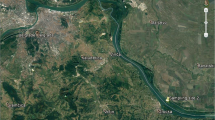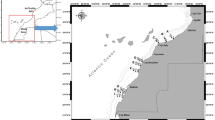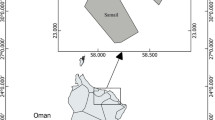Abstract
In this study, concentrations of 16 elements were quantified in muscles and livers of 141 fishes belonging to five commercially species. It was also our intention to evaluate potential risks to human health associated with seafood consumption. The grunt, flathead, greasy grouper, tiger-tooth croaker and silver pomfret fish species were obtained from Abadan, Deylam, Bushehr-Nirogah, Dayyer port, Lengeh port and Abbas port in Hormozgan, Bushehr and Khozesran provinces at the Iranian waters of the Persian Gulf. The contents of Al, As, Be, Cd, Cr, Co, Cu, Fe, Pb, Mn, Mo, Ni, Sb, Tl, V and Zn in fish muscles and livers were determined by Inductively Coupled Plasma Mass Spectrometry (ICP MS), after digestion in a CEM (Mars 5) microwave oven using nitric acid and hydrogen peroxide. Our results indicated that almost all metals were more accumulated in younger flathead, greasy grouper and tiger-tooth fishes. Contrary to the other fish species, grunt seems to stronger accumulating elements in the older fishes. Strong and positive correlations were observed in three or more of the fish species between V, Al, Fe, Tl, Co and Pb. The results confirmed that fish muscle and liver tissues appeared to be good bio-indicators for identification of coastal areas exposed to metallic contaminants. The results also showed that the element levels in the muscles of all fishes in our study were lower than the maximum allowable concentrations and pose no threat to public health, except for arsenic.
Similar content being viewed by others
References
Al-Arfaj, A. A., & Alam, I. A. (1993). Chemical characterization of sediments from the Gulf area after the 1991 oil spill. Marine Pollution Bulletin, 27, 97–101. doi:10.1016/0025-326X(93)90013-A.
Andrade, L., Marcet, P., Fernández-Feal, L., Fernández-Feal, C., Covelo, E. F., & Vega, F. A. (2004). Impact of the Prestige oil spill on marsh soils: relationship between heavy metal, sulfide and total petroleum hydrocarbon contents at the Villarrube and Lires marshes (Galicia, Spain). Ciencias Marinas, 30, 477–487.
Asadi, H., & Dehghani, P. R. (1996). Satin of the Persian Gulf and Oman Sea (1st edn., p. 246). Iran Fishery Organization.
Ashraf, W. (2006). Levels of selected heavy metals in Tuna fish. The Arabian Journal for Science and Engineering, 31, 89–92.
Baeyens, W., Leermakers, M., De Gieter, M., Nguyen, H. L., Parmentier, K., Panutrakul, S., et al. (2005). Overview of trace metal contamination in the Scheldt estuary and effect of regulatory measures. Hydrobiologia, 540, 141–154. doi:10.1007/s10750-004-7129-4.
Blasco, J., Rubio, J. A., Forja, J., Gomez-Parra, A., & Establier, R. (1998). Heavy metals in some fishes of the mugilidae family from salt-pounds of Cadiz Bay SW Spain. Ecotoxicology and Environmental Restoration, 1, 71–77.
Coetzee, L., Du Preez, H. H., & Van Vuren, J. H. J. (2002). Metal Concentration in Clarias gariepinus and Labeo umbratus from the Olifants and Klein Olifant River, Mpumalanga, South Africa: Zinc, copper manganese, lead, chromium, nickel, aluminium and iron. Rand Afrikaans University, South Africa, 16 pp.
Collings, S. E., Johnson, M. S., & Leah, R. T. (1996). Metal contamination of angler. Caught fish from Mersey Estuary. Marine Environmental Research, 41, 281–297. doi:10.1016/0141-1136(95)00020-8.
De Gieter, M., & Baeyens, W. (2005). Arsenic in fish: Implications for human health. Reviews in Food and Nutrition Toxicity, CRC Press, Boca Raton, 4, 57–83.
De Gieter, M., Leermakers, M., Van Ryssen, R., Noyen, J., Goeyens, L., & Baeyens, W. (2002). Total and toxic arsenic levels in North sea fish-arch. Environ Cont Toxicol, 43, 406–417. doi:10.1007/s00244-002-1193-4.
Dural, M., Lugal Göksu, M. Z., Özak, A. A., & Derici, B. (2006). Bioaccumulation of some heavy metals in different tissues of Dicentrarchus labrax L, 1758, Sparus aurata L, 1758 and Mugil cephalus L, 1758 from the Çamlik Lagoon of the eastern coast of Mediterranean (Turkey). Environmental Monitoring and Assessment, 118, 65–74. doi:10.1007/s10661-006-0987-7.
Environment Organization of Iran (1996). Considering heavy metals, Cd, Pb, Cu, and Zn in muscle of four fish species (grunt, tiger-tooth, greasy grouper and silver pomfret) in the Persian Gulf by AAs. The Environmental Organization of Iran.
European Community, EC (2005). Commission Regulation No 78/2005 (pp. L16/43–L16/45). Official Journal of the Europaen Union (20.1.2005).
Fish base web site: http://www.fishbase.org/HOME.HTM.
Henry, F., Amara, R., Courcot, L., Lacouture, D., & Bertho, M. L. (2004). Heavy metals in four fish species from the French coast of the Eastern English Channel and Southern Bight of the North Sea. Environment International, 30, 675–683. doi:10.1016/j.envint.2003.12.007.
Joyeux, J.-C., Edmar, A., Campanha, F., & Coutinho de Jesus, H. (2004). Trace Metals Concentration in Estuarine Fishes from Vitoria Bay, Es, Brazil. Brazilian Archives of Biology and Technology, 47, 765–774. doi:10.1590/S1516-89132004000500012.
Kalay, M., Ay, O., & Canli, M. (1999). Heavy metal concentrations in fish tissues from the Northeast Mediterranean Sea. Bulletin of Environmental Contamination and Toxicology, 63, 673–681. doi:10.1007/s001289901033.
Kardovani, P. (1995). Iranian marine ecosystem (the Persian Gulf and the Caspian Sea) (Vols. 1 & 2). Tehran, Iran: Ghomes.
Khansari, E., Ghazi-Kansari, M., & Abdollahi, M. (2005). Heavy metal content of canned tuna fish. Food Chemistry, 93, 293–296. doi:10.1016/j.foodchem.2004.09.025.
Kotze, P., du Preez, H. H., & van Vuren, J. H. J. (1999). Bioaccumulation of copper and zinc in Oreochromis mossambicus and Clarias gariepinus, from the Olifants River, Mpumalanga, South Africa. Water S.A, 25(1). http://www.wrc.org.za.
Lawrence, J. F., Michalik, P., Tam, G., & Conacher, H. B. S. (1986). Identification of Arsenobetaine and arsenocholine in Canadian fish and shellfish by high-performance liquid chromatography with atomic absorption detection and confirmation by fast atom bombardment. mass spectrometry. Journal of Agricultural and Food Chemistry, 34, 315–319. doi:10.1021/jf00068a042.
Leung, K. M. Y., Morgan, I. J., Wu, R. S. S., Lau, T. C., Svavarsson, J., & Furness, R. W. (2001). Growth rate as a factor confounding the use of the dogwhelk Nucella lapillus as biomonitor of heavy metal contamination. Marine Ecology Progress Series, 221, 145–159. doi:10.3354/meps221145.
Licata, P., Tromberra, D., Cristani, M., Naccari, C., Martino, D., Calo, M., et al. (2005). Heavy metals in live rand muscle of bluefin tuna (Thunnus thynnus) caught in the straits of Messina (Sicily, Italy). Environmental Monitoring and Assessment, 107, 239–248. doi:10.1007/s10661-005-2382-1.
McFarlane, G. A., & Franxin, W. G. (1980). An examination of Cd, Cu and Hg concentrations in livers of northern pike, Esox lucius and white sucker, Catostomus commersoni, from five lakes near a base metal smelter at Flin Flon, Manitoba. Canadian Journal of Fisheries and Aquatic Sciences, 37, 1573–1578.
Metin., alta, Canpolat, zgr. (2006). The comparison of three cyprinid species in terms of heavy metals accumulation in some tissues Read Orbit web site. http://www.redorbit.com/news/entertainment/528670/the_comparison_of_three_cyprinid_species_in_terms_of_heavy/index.html.
Nahida, B., Al-Majed, Preston, M. R. (2000). An assessment of the total and methyl mercury content of zooplankton and fish tissue collected from Kuwait territorial waters. Marine Pollution Bulletin, 40, 298–307. doi:10.1016/S0025-326X(99)00217-9.
Nguyen, H. L., Leermakers, M., Kurunczi, S., Bozo, L., & Baeyens, W. (2005). Mercury distribution and speciation in Lake Balaton, Hungary. The Science of the Total Environment, 340, 231–246. doi:10.1016/j.scitotenv.2004.08.016.
Otchere, F. A. (2003). Heavy metals concentrations and burden in the bivalves (Anadara (Senilia) senilis, Crassostrea tulipa and Perna perna) from lagoons in Ghana: Model to describe mechanism of accumulation/excretion. African Journal of Biotechnology, 2(9), 280–287.
Peter, J. A. L., & Viraraghavan, T. (2005). A review of public health and environmental concerns. Environment International, 31, 493–501. doi:10.1016/j.envint.2004.09.003.
Pourang, N. (1995). Heavy metal bioaccumulation in different tissues of two fish species with regards to their feeding habits and trophic levels. Environmental Monitoring and Assessment, 35, 207–219. doi:10.1007/BF00547632.
Pourang, N., Tanabe, S., Rezvan, S., & Dennis, J. H. (2005). Trace elements accumulation in edible tissues of five sturgeon species from the Caspian Sea. Environmental Monitoring and Assessment, 100, 89–108. doi:10.1007/s10661-005-7054-7.
ROPME (1999). Regional report of the state of marine environment (ROPME Sea Area) translated by Fatemi M.R, Marine Environment Bureau of Iran (p. 165).
U.S. Environmental Protection Agency (1999). Integrated Risk Information System. Office of Health and Environmental Assessment, Environmental Criteria and Assessment Office Cincinnati, OH: US Environmental Protection Agency.
Vas, P., Gordon, J. D. M., Fielden, P. R., & Overnell, J. (1993). The trace metal ecology of the Icthyofauna in the Rockall Trough northeastern Atlantic. Marine Pollution Bulletin, 26, 607–612. doi:10.1016/0025-326X(93)90499-A.
Viana, F., Huertas, R., & Danulat, E. (2005). Heavy metal levels in fish from coastal waters of Uruguay. Environ Cont Toxicol, 48, 530–537. doi:10.1007/s00244-004-0100-6.
Villares, R., Real, C., Fernández, J. A., Aboal, J., & Carballeira, A. (2007). Use of an environmental specimen bank for evaluating the impact of the Prestige oil spill on the levels of trace elements in two species of Fucus on the coast of Galicia (NW Spain). The Science of the Total Environment, 374, 379–387. doi:10.1016/j.scitotenv.2006.12.032.
Watanabe, K. H., Desimone, F. W., Thiyagarajah, A., Hartley, W. R., & Hindrichs, A. E. (2003). Fish tissue quality in the lower Mississippi River and health risks from fish consumption. The Science of the Total Environment, 302, 109–126. doi:10.1016/S0048-9697(02)00396-0.
WHO (2004). Guidelines for drinking-water, 3rd Ed. (Vol. 1).
WHO (2005). Guidelines for drinking water. World Health Organization, Geneva.
Youn-Joo, A. (2003). Total, dissolved, and bio-available metals at Lake Texoma marinas. Environmental Pollution, 122, 253–259. doi:10.1016/S0269-7491(02)00291-9.
Author information
Authors and Affiliations
Corresponding author
Rights and permissions
About this article
Cite this article
Agah, H., Leermakers, M., Elskens, M. et al. Accumulation of trace metals in the muscle and liver tissues of five fish species from the Persian Gulf. Environ Monit Assess 157, 499–514 (2009). https://doi.org/10.1007/s10661-008-0551-8
Received:
Accepted:
Published:
Issue Date:
DOI: https://doi.org/10.1007/s10661-008-0551-8




